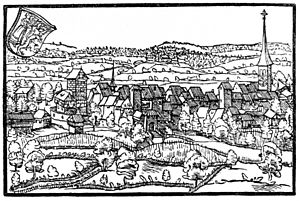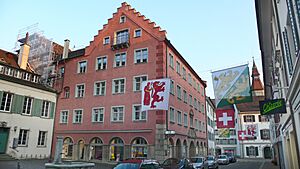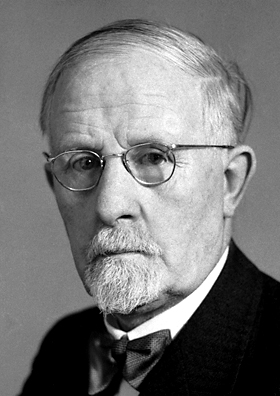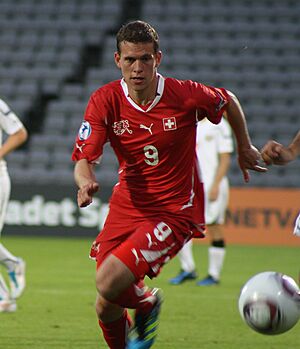Frauenfeld facts for kids
Quick facts for kids
Frauenfeld
|
||
|---|---|---|
 |
||
|
||
| Country | Switzerland | |
| Canton | Thurgau | |
| District | Frauenfeld | |
| Area | ||
| • Total | 27.36 km2 (10.56 sq mi) | |
| Elevation
(Church)
|
405 m (1,329 ft) | |
| Highest elevation
(Stääli at Oberherten)
|
593 m (1,946 ft) | |
| Lowest elevation
(Brüel at Horgenbach)
|
380 m (1,250 ft) | |
| Population
(Dec 2020 )
|
||
| • Total | 25,974 | |
| • Density | 949.34/km2 (2,458.8/sq mi) | |
| Postal code |
8500
|
|
| Localities | Gerlikon, Herten, Horgenbach, Huben, Kurzdorf, Langdorf, Schönenhof, Zelgli | |
| Surrounded by | Aadorf, Bertschikon bei Attikon (ZH), Ellikon an der Thur (ZH), Felben-Wellhausen, Gachnang, Hagenbuch (ZH), Matzingen, Thundorf, Uesslingen-Buch, Warth-Weiningen | |
| Twin towns | Kufstein (Austria) | |
Frauenfeld is the capital city of the Thurgau canton in Switzerland. It's a special place because it's the main city for the whole region.
The official language in Frauenfeld is German. But most people speak a local dialect called Alemannic Swiss German.
Contents
History of Frauenfeld
Early Settlements and Roman Times
People have lived in the Frauenfeld area for a very long time. We know this from ancient graves found east of Langdorf. A Roman road used to pass through what is now Frauenfeld.
Two Roman villas, which were like large country houses, were found nearby. One of these villas became the center of a later settlement called Oberkirch. An old cemetery was built on the ruins of the villa. By the 800s, a church was built there too.
In the 1200s, the area around Frauenfeld was part of a large farm owned by a church or monastery. This farm was called Erching. It had a main house, twelve smaller houses, and at least one mill.
How Frauenfeld Began
Around the late 1100s, two small villages started to grow. One was near Erching, and the other was around the Oberkirch church.
By the 1220s, a strong tower with a mill and a small church was built. A third village began to grow around this tower. This village eventually became Frauenfeld. The tower grew into the Frauenfeld Castle.
Frauenfeld is first mentioned in records in 1246 as Vrowinvelt. It slowly grew bigger during the 1200s. In 1286, Frauenfeld was first called a city. This means it had become an important place.
Frauenfeld in the Swiss Confederation
Frauenfeld was an important center even when it was controlled by the Habsburg family. When it became part of the Swiss Confederation in 1460, it became even more important. It was the place where the Swiss leaders managed the whole Thurgau region.
From 1500, Frauenfeld was often the meeting place for the Tagsatzung, which was like the Swiss parliament. It also became home to a Confederation court. After 1504, the governor of Thurgau lived in Frauenfeld, and after 1532, he lived in the castle.
The city grew, but it wasn't very strongly fortified. Most houses were made of wood. In 1771 and 1788, two big fires destroyed almost all the old wooden houses. So, most of the buildings you see in the old city today were built after these fires.
The Protestant Reformation also changed the city. Even though most people became Protestant, the city council always had Catholic members. Both Protestants and Catholics shared the main city church for a while.
Modern Times in Frauenfeld
When the French invaded Switzerland in 1798, the Helvetic Republic was formed. Thurgau became a full canton, and Frauenfeld was chosen as its capital. This was a big deal!
On May 25, 1799, Frauenfeld became a battlefield during a war between French and Austrian armies.
After 1800, more people were allowed to move into and become citizens of Frauenfeld. Between 1808 and 1834, the old city walls were taken down. In 1809, the Thurgauer Zeitung, a newspaper that is still published today, started.
Over the years, several smaller towns and villages joined Frauenfeld. Langdorf, Kurzdorf, Huben, Herten, and Horgenbach joined in 1919. Later, in 1998, Gerlikon, Schönenhof, and Zelgli also became part of Frauenfeld.
Geography of Frauenfeld
Frauenfeld covers an area of about 27.37 square kilometers (10.57 square miles). A large part of this land, about 45.4%, is used for farming. Forests cover about 24.7% of the area. Buildings and roads make up about 27.8% of the land.
The city is located on both sides of the Murg river. It includes the old city center and several former communities that are now part of Frauenfeld.
Population and People
Frauenfeld has a population of over 22,000 people. Many different nationalities live here. Most people in Frauenfeld speak German. Italian and Portuguese are also commonly spoken.
The population has been growing steadily over the years. In 2009, about 9.3% of the population were children aged 0-9, and 10.9% were teenagers aged 10-19.
Historical Population Data
Here's how Frauenfeld's population has changed over time:
| year | population | % German Speaking | % Italian Speaking | % Other Languages | % Protestant | % Catholic | % Jewish | % Muslim | % No Specific Religion | % Swiss | % Non-Swiss |
|---|---|---|---|---|---|---|---|---|---|---|---|
| Middle Ages | 80-120 Houses | ||||||||||
| 1443 | 113 Taxable Households | ||||||||||
| 1850 | 3,444 | - | - | - | 82.6% | 17.4% | - | - | - | 95.4% | 4.6% |
| 1870 | 5,122 | - | - | - | 78.7% | 21.1% | - | - | - | 93.3% | 7.0% |
| 1888 | 5,996 | 99.0% | 0.5% | 0.5% | 74.1% | 25.3% | 0.1% | - | - | 90.0% | 10.0% |
| 1900 | 7,761 | 96.3% | 2.7% | 1.0% | 71.7% | 28.2% | 0.1% | - | - | 84.5% | 15.5% |
| 1910 | 8,459 | 95.1% | 3.9% | 1.0% | 70.7% | 28.1% | 0.1% | - | - | 84.3% | 15.7% |
| 1930 | 8,795 | 96.9% | 2.1% | 1.0% | 71.2% | 28.1% | 0.1% | - | - | 90.3% | 9.7% |
| 1950 | 11,114 | 94.8% | 3.6% | 1.6% | 67.9% | 31.2% | 0.1% | - | - | 93.4% | 6.6% |
| 1970 | 17,576 | 81.3% | 14.1% | 4.6% | 55.1% | 43.0% | 0.1% | 0.5% | 0.4% | 78.3% | 21.7% |
| 1990 | 20,204 | 81.1% | 7.5% | 11.4% | 49.1% | 41.5% | 0.1% | 2.5% | 4.0% | 77.4% | 22.6% |
| 2000 | 21,954 | 83.3% | 4.7% | 11.9% | 44.3% | 37.5% | 0.5% | 4.8% | 7.2% | 75.7% | 24.3% |
Important Buildings and Heritage Sites
Frauenfeld has ten buildings that are considered very important Swiss heritage sites. These include:
- Four archives and a library, like the State Archives of the Canton and the Cantonal Library.
- Two churches: the Catholic City Church and the shared Church of St Laurenzen.
- Two museums: the Museum of Archeology and Natural History, and Frauenfeld Castle which holds the Historical Museum.
- The Rathaus, which is the town council house.
The entire old city of Frauenfeld is also a protected heritage site.
Economy and Jobs
Frauenfeld has many jobs in different areas. In 2005, about 211 people worked in farming. Over 4,000 people worked in manufacturing and industry. The largest number of people, about 11,759, worked in services like shops, offices, and healthcare.
Many people who live in Frauenfeld also work there. About 16.4% of workers use public transportation to get to work, and 42.7% use a private car. The company Sigg, famous for its reusable water bottles, has its main office in Frauenfeld.
Religion in Frauenfeld
According to a 2000 census, most people in Frauenfeld are either Swiss Reformed (Protestant) or Roman Catholic. There are also smaller groups of people who follow other Christian faiths, Islam, or no religion.
Weather in Frauenfeld
Frauenfeld usually has about 133 days of rain or snow each year. On average, it gets about 1072 millimeters (42 inches) of rain or snow. June is usually the wettest month, with about 127 millimeters (5 inches) of precipitation. March is the driest month.
Education in Frauenfeld
Many adults in Frauenfeld have completed higher education. The city is home to the Kantonsbibliothek Thurgau, which is a large library. In 2008, this library had over 276,000 books and other media.
Transportation
Frauenfeld is a key transport hub in western Thurgau. It has a main railway station and two exits on the A7 motorway.
The city has a bus service with 5 lines that run every 15 minutes, connecting different parts of the town. The Frauenfeld railway station is served by regional trains that go to Weinfelden and Winterthur. Fast trains also connect Frauenfeld to Zürich and other cities like Constance in Germany.
Frauenfeld is also the starting point for the narrow-gauge Frauenfeld–Wil line. These trains go to Wil every half hour.
Twin Towns
Frauenfeld is twinned with one town:
|
Notable People from Frauenfeld
Many interesting people have come from Frauenfeld, including:
- Petrus Dasypodius (around 1495–1559), a writer and teacher.
- Julius Maggi (1846–1912), who invented famous precooked soups and Maggi sauce.
- Alfred Ilg (1854–1916), an engineer who was a close friend of Emperor Menelik II of Ethiopia.
- Heinrich Häberlin (1868–1947), a politician and judge who was part of the Swiss government.
- Walter Rudolf Hess (1881–1973), a scientist who won the Nobel Prize in Physiology or Medicine in 1949 for his work on the brain.
- René Hubert (1895–1976), a costume designer who was nominated for two Academy Awards.
Sports Stars
Frauenfeld has also produced many talented athletes:
- Rolf Bernhard (born 1949), a retired long jumper who competed in the Olympics.
- Pascal Zuberbühler (born 1971), a former football goalkeeper.
- Patrick Heuscher (born 1976), a beach volleyball player who won a bronze medal at the 2004 Summer Olympics.
- Fabian Frei (born 1989), a footballer who has played many games for clubs and for the Swiss national team.
- Antonio Djakovic (born 2002), a swimmer who competed at the 2020 Summer Olympics.
See also
 In Spanish: Frauenfeld para niños
In Spanish: Frauenfeld para niños


















